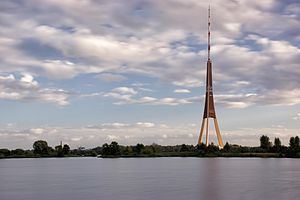Type Mixed-use Completed 1989 Roof 222 m (728 ft) Opened January 1986 Lifts/elevators 4 | Antenna spire 368 m (1,207 ft) Height 368 m Construction started 1979 | |
 | ||
Architect Kims NikuradzeNikolajs SergijevskisViktors Savčenko Similar St Peter's Church - Riga, Kiev TV Tower, Museum of the Occupati, Nativity Cathedral - Riga, Freedom Monument | ||
Riga radio and tv tower
The Riga Radio and TV Tower (Latvian: Rīgas radio un televīzijas tornis) in Riga, Latvia is the tallest tower in the European Union. It was built between 1979 and 1989 with funding from the central government of the Soviet Union. Its highest point reaches 368 metres (1,207 ft),† which makes it the third tallest tower in Europe (after the Ostankino Tower at 540 metres (1,770 ft) and the Kiev TV Tower at 385 metres (1,263 ft)) and the 15th tallest self-supporting tower in the world.
Contents
- Riga radio and tv tower
- Map of Riga Radio and TV Tower Zemgale Suburb Riga LV 1050 Latvia
- Features
- Construction
- Bottom section
- Middle section
- Top section
- Operations
- References
Map of Riga Radio and TV Tower, Zemgale Suburb, Riga, LV-1050, Latvia
Features
There was a restaurant, "Vēja Roze", at the 93-metre (305 ft) level, which has closed. There is a public observation platform just above it at 97 metres (318 ft), from which most of the city and surroundings and the Gulf of Riga can be seen.
Construction
The design chosen for the tower was that of Georgian architect Kims Nikurdze. Also credited are Nikolajs Sergijevskis and Viktors Savčenko. Construction materials included dolomite from Saaremaa, Karelian granite, and ironwork that had been prefabricated in Chelyabinsk. The assembly was done by the St Petersburg North-western Ironwork Assembly Trust.
The tower is built on an island called Zaķusala in the middle of the River Daugava, and the base of the tower is located about 7 metres (23 ft) above mean sea level. The tower is built to resist winds up to 44 metres per second (98 mph) without any noticeable vibration with the help of three 9.1-metric-ton (10-short-ton) dampers installed at the 198-metre (650 ft) level. Though seismic activity is rare, the tower was designed to withstand a magnitude 7.5 earthquake. The projected service life of the tower is 250 years.
Bottom section
The support section of the tower rises the first 88 metres (289 ft), comprising the three pillars that give the tower it's unusual appearance, and a central building that contains offices and machine rooms. There are two high-speed sloping elevators, one in the north-east pillar and one in the south-west pillar, that ascend the bottom section in just 42 seconds. The third pillar contains a staircase. It is one of only three "tall" towers in the world that has 3 pillars; the others are the Avala Tower in Belgrade and Žižkov Television Tower in Prague.
Middle section
The middle section, at 88–222 metres (289–728 ft), contains equipment and a central elevator and is enclosed by panels of COR-TEN, an aluminum-iron alloy.
Top section
The top section, at 222–368 metres (728–1,207 ft), is a cylindrical structure which supports and contains the various antennas, and is topped by a flagpole. An elevator rises to the machine rooms at the 308-metre (1,010 ft) level, and stairs ascend another 44 metres (144 ft).
Operations
The tower started broadcasting regularly in January 1986, though construction work continued until 1989.
The following television channels are broadcast from the tower:
The following radio stations broadcast from the tower:
Additionally, broadcast and two-way communications services are provided for various organizations and government agencies.
